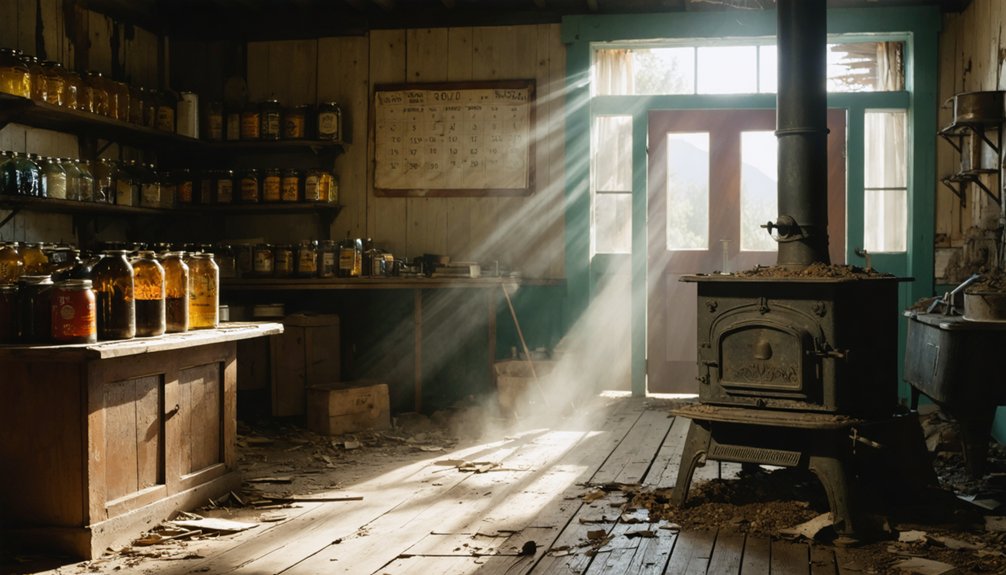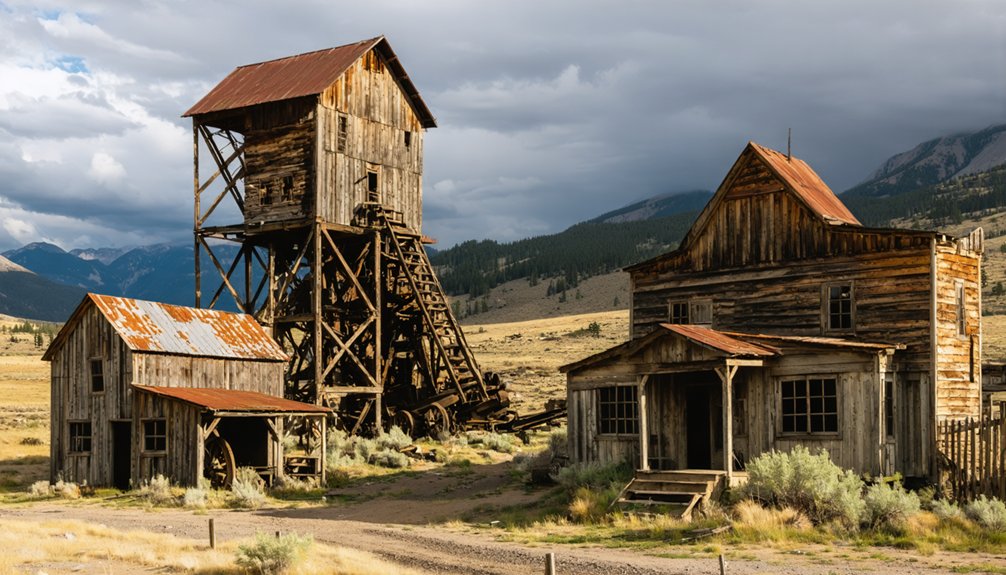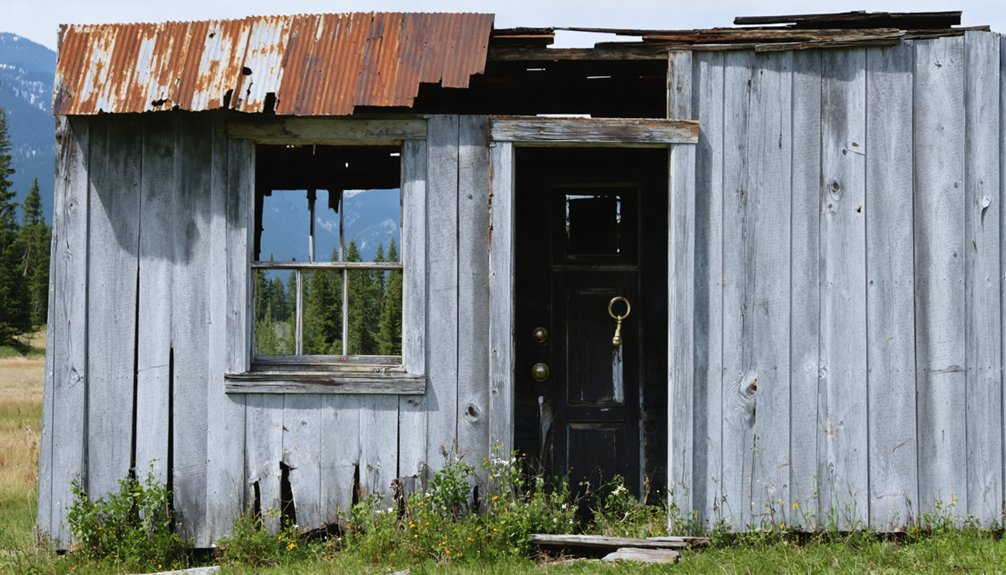You’ll find the ghost town of Cobalt nestled in Idaho’s rugged mountains, where America’s only primary cobalt mine once thrived from 1949 to 1960. The Blackbird district produced over 14 million pounds of cobalt, supporting 300 residents who worked the mine’s 12 levels stretching 14 miles underground. Today, abandoned tunnels, weathered cabins, and industrial remnants tell the story of this Cold War-era mining community, while its Superfund status reveals a complex environmental legacy.
Key Takeaways
- Cobalt, Idaho transformed from a thriving mining community to a ghost town following the closure of Blackbird Mine in 1960.
- The town’s peak activity centered around America’s only primary cobalt producer, extracting 268,392 metric tons of ore in 1958.
- During its heyday, the mining town supported 300 residents with basic amenities including a bowling alley and gas station.
- The mine’s closure triggered a mass exodus of workers and families, leaving behind abandoned structures and mining equipment.
- Environmental damage led to Superfund site designation in 1983, with contamination affecting over 10,000 acres of surrounding land.
The Rise of a Mining Community
When prospectors first identified cobalt deposits in Idaho’s rugged terrain around 1900, they couldn’t have imagined the thriving mining community that would soon emerge.
Within decades, the Blackbird district transformed into a bustling hub of activity, producing over 14 million pounds of cobalt between 1952 and 1959 alone. You’d have witnessed remarkable community growth as mining families flocked to the area, drawn by lucrative job opportunities and government-contracted prices of $2.30 per pound for cobalt.
The Idaho Cobalt Belt, stretching 34-55 miles, became the backbone of local prosperity. Mining companies built housing, stores, and essential infrastructure to support their workers. Today, this historic region continues to attract interest as Koba Resources Limited investigates new deposits on U.S. Forest Service land.
While market volatility occasionally disrupted operations, like the 1960 shutdown and 1967 restart, the community’s spirit remained resilient through boom and bust cycles.
Life in the Blackbird Mining Era
Working at Blackbird Mine in the 1950s, you’d spend your days traversing the dark underground shafts, extracting valuable cobalt and copper ore alongside crews of skilled miners.
You’d start your shift by descending into the cool depths, armed with hard hats, safety lamps, and heavy equipment needed to drill, blast, and haul out the rich mineral deposits that made this remote Idaho operation America’s only primary cobalt producer. The mine’s impressive production peaked in 1958 when workers extracted 268,392 metric tons of ore. Between 1949 and 1960, the operation maintained steady production of ore containing cobaltite and chalcopyrite, the main mineral sources of cobalt and copper at the site.
After emerging from the dusty tunnels, you’d join your fellow workers in the small mining community, where the rhythm of daily life revolved around the constant hum of ore processing and the shared experiences of mountain isolation.
Mining Town Daily Routines
Life in Cobalt during the 1950s Blackbird mining era revolved around the steady rhythm of shift work and community gatherings.
You’d start your daily routines before dawn, gathering gear and joining fellow miners for safety briefings before heading underground. After long shifts, you’d find comfort in local establishments where the mining lifestyle fostered strong bonds among workers and their families.
Your days weren’t just about working the mines – you’d spend time at the bowling alley or catch up with neighbors at the gas station. Miners had to be cautious of toxic lead exposure that plagued many mining communities of that era.
The town’s 300 residents made the most of basic amenities, with children attending the local school while parents tackled extended work hours. The mine’s operations left a lasting impact, with contaminated waterways requiring extensive cleanup efforts in later years.
Despite economic pressures and labor tensions, you’d find strength in community support, sharing stories and challenges with those who understood the demanding nature of mining life.
Working Underground During 1950s
The underground maze of Blackbird Mine stretched an impressive 14 miles beneath Idaho’s rugged terrain during the 1950s.
You’d find yourself descending through 12 different levels, maneuvering through the dark tunnels where underground dangers lurked around every corner. The miner camaraderie was essential as you’d extract cobalt and copper from the depths, processing about 1,000 tons of ore daily through the flotation mills. This operation would ultimately yield 63 million pounds of copper throughout its lifetime. The mine’s horizontal cut and fill method allowed miners to carefully inspect ore faces after each round.
Your daily challenges would include:
- Hauling heavy equipment through steep-walled canyon tunnels
- Managing waste rock disposal outside numerous mine portals
- Dealing with periodic tailings spills and pipeline leaks
You’d be part of America’s only primary cobalt production team, working the rich veins that yielded ore grades between 0.42% and 0.81% cobalt, while facing the constant challenges of underground mining life.
Cold War Influence and Peak Operations
During America’s Cold War era, Idaho’s Blackbird Mine emerged as an essential strategic asset when full-scale cobalt mining began in 1949.
You’d find the U.S. government actively pushing for increased cobalt extraction to support military needs, especially in jet engine manufacturing. The mine’s strategic importance meant environmental concerns took a backseat to national security priorities.
At its peak, you could see massive operations extracting roughly 5 million tonnes of ore between 1938 and 1969. The environmental impact led to the area being designated as a superfund site later. The region contained an estimated 17 million tonnes of high-grade cobalt resources.
The mining boom transformed local communities like Salmon, where new roads and infrastructure sprouted up to support the thriving industry.
While copper and gold came from the mine too, it’s the cobalt that made Blackbird a significant player in America’s military-industrial complex, fueling technological advancements and defense capabilities throughout the Cold War period.
Environmental Challenges and Superfund Status
After decades of intensive mining operations, Blackbird Mine’s environmental toll became impossible to ignore, leading to its designation as a Superfund site in 1983.
You’ll find the contamination impact spread across thousands of acres, affecting everything from local streams to groundwater sources that once supported thriving ecosystems.
- By the early 1960s, toxic metal runoff had wiped out Panther Creek’s Chinook salmon population.
- The site’s massive scale – 10,830 acres of both underground and open-pit contamination – has complicated environmental restoration efforts.
- Legal battles delayed cleanup until 1995, when teams finally began treating water, stabilizing waste rock, and removing contaminated soil.
Despite ongoing treatment efforts and modern safeguards at the adjacent Idaho Cobalt Operations, you’re looking at decades more work before the ecosystem fully recovers.
The region’s outfitters and guides have seen their livelihoods directly impacted by the degradation of local fish populations.
Ghost Town Transformation

While Cobalt, Idaho once bustled with the rhythms of mining machinery and workers’ footsteps, you’ll now find only ghostly remnants of its former prosperity.
The town’s transformation from a thriving mining hub to a ghost town mirrors the boom-and-bust cycle that’s shaped many Western communities.
You can trace Cobalt’s economic decline through the 1960 mine closure, which triggered a mass exodus of workers and their families.
Despite a brief revival attempt in the early 1980s with a $35,000 investment, the community’s resilience couldn’t overcome unstable cobalt prices.
Today, you’ll discover collapsed mill frameworks and weathered structures telling stories of a bygone era.
While some preservation efforts maintain basic historical markers, Cobalt stands as a reflection of the fragile nature of single-industry towns in the American West.
Remaining Structures and Landmarks
As you explore Cobalt’s rugged terrain, you’ll find a network of abandoned mining tunnels and partially collapsed shafts that once yielded rich cobalt ore deposits.
The skeletal remains of industrial buildings dot the landscape, with several structures having been relocated to nearby Salmon for preservation.
A few weathered cabin remnants and mining equipment foundations still stand along Panther Creek, offering glimpses into the town’s bustling mining past.
Mining Tunnels and Shafts
Deep beneath the rugged terrain of Cobalt, Idaho’s ghost town, an intricate network of mining tunnels and shafts still pierces the Middle Proterozoic Yellowjacket Formation.
You’ll find these abandoned workings stretching throughout the famous Idaho Cobalt Belt, where tunnel exploration isn’t recommended due to safety concerns and environmental restrictions.
- The extensive underground network includes multiple stratabound zones, particularly the Idaho and Blacktail sections.
- A massive 12-acre open pit remains as a stark reminder of the area’s mining heritage.
- The Glory Hole’s design connected surface operations to the deeper tunnel systems.
While you can’t venture into these historic passages today, they stand as silent witnesses to the Cold War era when the Blackbird Mine’s cobalt production powered America’s jet engine manufacturing industry.
Collapsed Industrial Buildings
The skeletal remains of Cobalt’s industrial might stand as crumbling sentinels throughout the ghost town’s landscape.
As you explore the site, you’ll find scattered evidence of industrial decay – massive rusted boilers, twisted ore carts, and forgotten machinery parts that tell the story of this once-bustling mining operation.
The most prominent structural remnants you’ll encounter are the stone foundations and partial walls of the main mill and smelter complex.
While wooden elements have long since rotted away, the locally quarried stonework has weathered time’s passage more successfully.
Look for surviving architectural features like arched doorways and the occasional ore chute still clinging to deteriorating walls.
Metal fragments, from corrugated roofing to machinery bolts, litter the ground around these industrial ruins.
Historic Cabin Remnants
Scattered throughout Cobalt’s pine-covered slopes, rustic log cabins stand as weathered testimonials to the town’s mining heritage.
These frontier dwellings reveal the resourceful cabin architecture of early settlers, with their flip-out windows and attached pantries built to endure harsh Idaho winters.
- You’ll find evidence of miner lifestyles in the remaining structures, from simple stone foundations to small window openings that once sheltered prospectors from the mountain elements.
- Near the cabins, you can explore scattered mining artifacts, from rusted ore carts to tool remnants that tell tales of the daily grind.
- While many cabins have lost their roofs to time, several still invite you inside to experience the intimate spaces where miners once dreamed of striking it rich in these remote mountains.
Mining Legacy in Lemhi County
Mining transformed Lemhi County’s landscape after prospectors discovered gold in Napias Creek in 1866, spawning the boomtown of Leesburg and kickstarting decades of mineral extraction.
Early placer mining dominated the scene, generating about two-thirds of the county’s $13.7 million gold production by 1911.
Placer mining ruled early gold production in Lemhi County, yielding over $9 million by the dawn of the 20th century.
You’ll find evidence of over 900 mines scattered throughout the region, each telling a story of the area’s rich mineral wealth.
The economic impact stretched far beyond gold, with the Blackbird mine’s cobalt-copper operations becoming the county’s most valuable producer.
Lead-silver deposits at Gilmore yielded $12 million, while Patterson’s tungsten operations brought in $10 million.
Despite transportation challenges that initially limited development, the mining industry shaped Lemhi County’s destiny well into the mid-20th century.
Preserving Idaho’s Mining Heritage

While Idaho’s mining boom days have faded into history, dedicated preservation efforts across the state work tirelessly to protect this essential heritage.
You’ll find local historical societies and preservation committees working hand-in-hand with organizations like the Idaho Heritage Trust to safeguard the remnants of this bygone era.
- Through partnerships with federal agencies, you can explore preserved mining artifacts at sites like Mackay Mine Hill, where interpretive signs bring the past to life.
- You’re able to witness authentic restoration work on historic structures, from tramway towers to assay offices, maintained with their original architectural features.
- You’ll discover how Save America’s Treasures grants help protect these cultural treasures, ensuring future generations can experience Idaho’s rich mining heritage firsthand.
Planning Your Ghost Town Visit
Before starting your journey to Cobalt and other nearby ghost towns, you’ll need to plan carefully for the rugged Idaho terrain and remote conditions.
Your travel logistics should include a high-clearance vehicle, detailed maps, and GPS devices, as cell service is virtually nonexistent. Check seasonal road closures, especially from November through May when access becomes challenging.
Pack essential safety tips into action: wear sturdy hiking boots, carry plenty of water and snacks, and always inform someone of your plans.
You’ll want your camera ready for capturing the historic mining structures, but remember to leave everything as you find it. Stick to established trails and respect any posted signs about active claims or restricted areas.
Consider stopping at the Lemhi County Historical Museum to enrich your ghost town adventure with local context.
Frequently Asked Questions
Are There Any Dangerous Animals or Wildlife Near Cobalt’s Ghost Town Ruins?
You’ll need to watch for black bears, mountain lions, and snakes when exploring. For wildlife safety, carry bear spray and stay alert – unexpected animal encounters happen in these forested mountains.
What Items of Value Were Left Behind When Residents Abandoned Cobalt?
You won’t find reliable information about abandoned treasures or historical artifacts since there’s no documented record of what residents left behind when they departed this obscure Idaho mining settlement.
Has Anyone Reported Paranormal Activity or Ghost Sightings in Cobalt?
While other Idaho ghost towns boast chilling tales, you won’t find documented ghost sightings or paranormal experiences in Cobalt. Unlike Burke or Bonanza, this town’s spirits remain mysteriously quiet to visitors.
Can Metal Detectors Be Legally Used at the Cobalt Ghost Town Site?
You can’t legally use metal detectors at this site without proper permits. Metal detecting laws and treasure hunting regulations protect historical artifacts over 100 years old under federal protection statutes.
Does Anyone Still Own Private Property Within the Original Cobalt Townsite?
You’ll find current ownership and property rights in the original townsite are unclear – while some historic structures remain, most land appears to be public, with any private holdings being minimal or undocumented.
References
- https://lemhi.idgenweb.org/places.html
- https://www.visitsalmonvalley.com/historic-adventures/ghost-towns/
- https://abcnews.go.com/US/idaho-cobalt-mining-devastated-local-water-revisited-greener/story?id=88754951
- https://history.idaho.gov/wp-content/uploads/2018/08/0064.pdf
- https://visitidaho.org/things-to-do/ghost-towns-mining-history/
- https://en.wikipedia.org/wiki/List_of_ghost_towns_in_Idaho
- https://www.youtube.com/watch?v=8yl7A2sR-dw
- https://www.idahogeology.org/pub/Pamphlets/P-131.pdf
- https://history.idaho.gov/wp-content/uploads/2018/08/0009.pdf
- https://timelines.issarice.com/wiki/Timeline_of_cobalt



